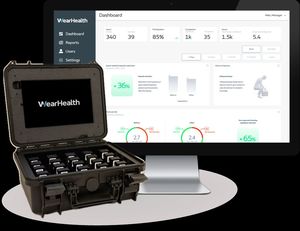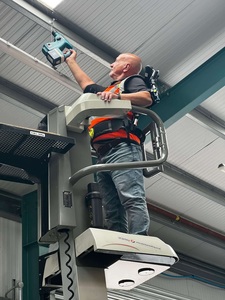
 |
Mark Sennett
Managing Editor |
 |
Kelly Rose
Editor |
| Home> | Health & Wellbeing | >General Health & Wellbeing | >AI has your back |
AI has your back
23 July 2025
Exoskeletons and smart technologies are transforming the way we work, says Graham Sharp.

ARTIFICIAL INTELLIGENCE (AI) wearable technology continues to transform workplace safety and productivity in the UK as it updates and becomes more affordable than ever. This type of AI enabled technology is increasingly being seen as an essential part of PPE for management teams who understand the benefits that they bring for improved health and safety training and support - particularly useful in sectors where bending, reaching, lifting and carrying is the norm e.g. manufacturing, engineering and construction. Artificial intelligence capabilities additionally allow these devices to analyse and interpret detailed data direct from the wearer and quickly spot weaknesses which can help inform future workplace health and safety policy within organisations.
Prevention is the cure – smart technology to mitigate risk
One of the fastest growing technologies within the health and safety space, are AI driven ergonomic wearable solutions which aim to bring about behaviour change, cut accident rates and prevent them from re-occurring. These usually come in the form of small devices which are clipped onto the body and alert the wearer of risky movement through haptic feedback. The wearable device monitors musculoskeletal risks associated with bending, crouching, twisting, movement acceleration and aggressive motions. Each individual's movement is recorded and analysed to help build a data map of potential risk and see what patterns are emerging from the data.
One of the newest and most affordable of these, is WearHealth’s “Wear” technology, which is an easy to use out-of the-box solution that can be clipped onto the body in a position most suited to the task being performed. The compact kit comes with 20-30 devices which can be tested over the course of two months across the business at a fixed fee and rotated around different workers. At the end of that time, health and safety managers can use the AI enabled device to analyse the data collected from wearer to assess behaviour change, measure accident rates and gain feedback from users.
The technology is designed to identify and mitigate workforce risks and guarantees a 30%+ reduction in hazardous movements within just two months. The system does not require IT integration or complex hardware installation and can be rolled out in under two hours, offering real-time feedback and advanced data analysis. This product is a huge step forward in making this type of solution more affordable and accessible than ever before.
Anti-collision technology
Alongside behaviour change technology, clip on body worn technology prevents accidents between workers and machines. For example, Modjoul’s wearable SmartBelt is able to communicate with forklift drivers and other workers in the vicinity, while simultaneously measuring ergonomics and environmental factors. If a forklift is nearby, the SmartBelt technology will alert both the driver of the forklift and the individual concerned so that they can avoid each other and in the most severe cases, automatically stop the truck completely to prevent a collision. This is particularly useful in areas where vision may be restricted such as blind corners, meaning that in workplaces where workers and forklifts co-exist together, processes can operate more safely than ever before.
Exoskeleton solutions to provide support and cut injury rates
According to the latest Health and Safety Executive (HSE) statistics, Musculoskeletal disorders (MSDs) like back injuries, are one of the key reasons that workers take time off sick in the UK with 543,00 workers in the UK suffering from work-related musculoskeletal disorders in 2023/24 and 7.8 million working days lost due to work-related musculoskeletal disorders. Wearable technology solutions like exoskeletons are a game changer for many physically demanding job roles and are being used to help take the load, providing support to workers and keeping them safe when they have to lift or move heavy objects repetitively, combat fatigue and improve endurance on tasks.
Technology providers like WearHealth use video scanning technology which helps match the right exoskeleton suit to the physical task being performed, with the aim of ensuring that the suit can assist in the usual daily tasks without the wearer being exposed to musculoskeletal injury as a result. A consultant expert can help to identify which is the best suit to fit the task in hand, out of the many that are on the market. A rigorous pre-assessment process is then followed that helps to identify the issues that workers most commonly face in executing a specific activity. The worker is videoed performing the task and this is then processed via an algorithm to produce a comprehensive report of recommended exosuits. An ergonomist reviews the recommendations before it is shared with the client From there, the exoskeleton suit is then trialled by a small number of workers and feedback obtained from them before moving onto implementation.
It can take some time for workers to get accustomed to wearing the exoskeleton suit, which is why a phased approach is used. Each suit is designed to keep the worker safe and to protect and support their body to reduce MSDs. Using wearable sensors, the employer can view the before and after impact using data generated from wearing the suit to complete the task.
Case study
TECHNAL UK is a leading provider of innovative aluminium solutions, specialising in architectural systems for the construction industry. The business approached Stanley to provide them with support and advice to find an AI enabled exoskeleton solution that could be used to help provide support to their workers who were regularly lifting heavy metal profiles from racking, ready for dispatch to customers. Sometimes operatives needed to bend low into racking to pick heavy objects up and then hoist them up onto their shoulders. The Stanley team made recommendations and supervised a two-week trial that took place with the TECHNAL UK team consisting of a one-week induction, where the workers got used to wearing the exoskeletons and then one week with sensors, used before and after the intervention of the exoskeleton, to determine the difference. Workers reported instant relief, especially in the case of a younger worker in his 20s who commented that he immediately felt less fatigue and went home feeling better and would happily wear one all of the time while on shift. Stanley’s analysis of the suits included a precise assessment of core activities in a report, providing AI data-driven analysis that proved the effectiveness of the exoskeleton suit in enhancing worker comfort. The key results of that analysis showed that using the exoskeleton technology could potentially prevent lower back strain at work by 30%. In addition, using the exoskeletons could potentially reduce load on the back by up to 5 tons a day.
Enhanced training provision led by data analysis
One of the key advantages of these wearable technology solutions, is the data that can be downloaded and interrogated. The AI algorithms are able to analyse historical data on manual handling tasks, workplace conditions and injury records to quickly and easily identify patterns and correlations. By analysing this data, high-risk situations or tasks can be identified. Using data analytics, managers can build a picture of where the key health and safety weaknesses lie and where accidents are most likely to happen. The result of this comprehensive analysis quantifies the impact of tasks on workers’ health and safety and allows for more targeted health and safety training.
Since AI algorithms can identify patterns and factors that contribute to the occurrence of injuries, managers can ensure they proactively intervene to minimise risks. Predictive analytics can also help optimise work schedules, how workloads are distributed and task assignments to minimise the likelihood of injuries.
Results-driven planning
Integrating AI into workplace safety protocols is not just about compliance but about creating an environment where employees feel valued and protected. Companies that embrace these technologies are seeing a positive shift in employee morale and engagement. AI-based wearable technology also provides support to traditional style training programmes by encouraging behavioural change.
Once weak points have been identified and a comprehensive step-by-step training plan has been drawn up, organisations can adopt a more proactive approach to risk management using wearable technology to help bring about gradual behaviour change across an organisation. The changes can be tracked using real time data, target setting and easy ongoing assessments.
Big changes are already taking place in UK workplaces and in the future, we can expect to see these AI enabled technologies become a compulsory part of PPE in the same way as hard hats and safety boots. We can already it making a difference in workplaces across the UK, creating happier, healthier and safer workforces and automatically bringing greater productivity and efficiency gains to those who have embraced it.
Graham Sharp is managing director of Stanley. For more information, visit www.stanleyhandling.co.uk
- BSIF: Covid-19 Update
- Dust tight
- SAFEContractor for 5th year
- BSC welcomes proposals to slash legal costs in personal injury claims
- Get some insight
- Asbestos remains number one killer
- Chemical exposure course goes more than skin deep
- Getting workers involved in safety
- Dual drug testing
- On-site health screening


























